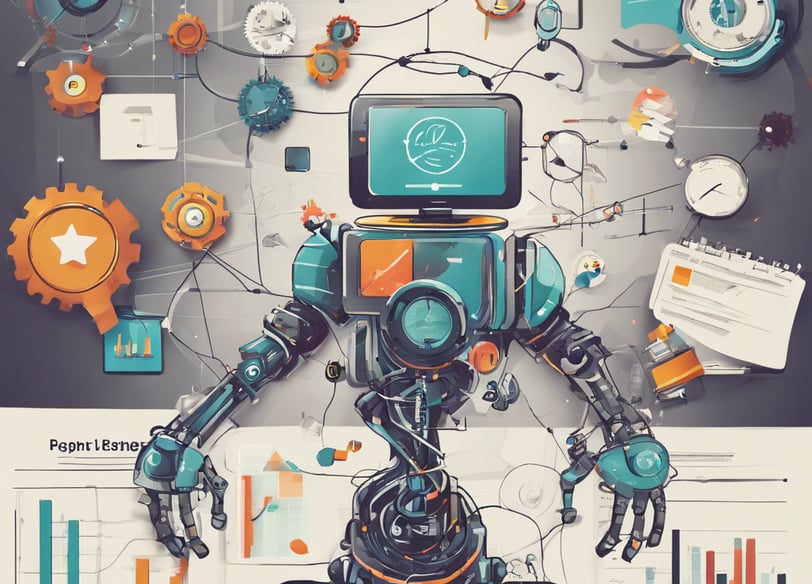A Day in the Life of a Software Tester: The Impact of AI on Daily Work
Software testing is a crucial component of the software development lifecycle, ensuring that products are reliable, secure, and perform well. The role of a software tester is dynamic and challenging, often involving a blend of analytical thinking, creativity, and technical skills. With the advent of artificial intelligence (AI), the landscape of software testing is evolving rapidly, bringing new tools and methodologies into the mix. In this blog, we will walk through a typical day in the life of a software tester and explore how AI is shaping their daily work.
Andrei Carindatoiu
7/8/20243 min citit


Morning: Planning and Preparation
9:00 AM – Daily Stand-Up Meeting
The day usually begins with a daily stand-up meeting, especially in agile environments. During this brief meeting, the tester updates the team on the progress of ongoing tasks, discusses any blockers, and plans the day ahead. This collaborative session sets the tone for a productive day.
9:30 AM – Reviewing Test Plans and Cases
After the stand-up, the tester reviews test plans and cases. This involves:
Ensuring test cases are up-to-date with the latest requirements.
Identifying any gaps in test coverage.
Planning which tests to execute based on the current project phase.
AI Impact: AI-powered tools can help automate the creation and maintenance of test cases. By analyzing code changes and user stories, AI can suggest new test cases and update existing ones, saving time and improving accuracy.
Mid-Morning: Test Execution and Analysis
10:30 AM – Automated Test Execution
Next, the tester initiates automated test runs. These tests, which may include unit tests, integration tests, and regression tests, are executed on various environments to ensure the software behaves as expected.
AI Impact: AI enhances automated testing by identifying which tests to run based on recent code changes. This selective testing approach reduces test execution time and helps focus on the most critical areas.
11:30 AM – Analyzing Test Results
Once the automated tests are complete, the tester analyzes the results. This involves:
Reviewing test logs and reports.
Identifying any failed tests and their root causes.
Collaborating with developers to address defects.
AI Impact: AI-driven analytics tools can quickly identify patterns in test results, highlighting potential problem areas and suggesting possible fixes. This speeds up the debugging process and improves test accuracy.
Afternoon: Manual Testing and Collaboration
1:00 PM – Manual Testing
Manual testing is an essential part of the testing process, focusing on areas that automated tests cannot cover, such as user interface (UI) and user experience (UX) testing. The tester conducts exploratory testing, usability testing, and other manual test types to ensure the application meets user expectations.
AI Impact: AI can assist in manual testing by recording and analyzing tester interactions with the application. This helps in identifying repetitive tasks that can be automated and provides insights into user behavior patterns.
3:00 PM – Bug Reporting and Documentation
After completing the testing tasks, the tester documents any identified defects and logs them into the bug tracking system. This includes providing detailed descriptions, steps to reproduce, and any relevant screenshots or logs.
AI Impact: AI can streamline bug reporting by automatically capturing and logging relevant information during testing sessions. This reduces the manual effort required and ensures consistency in bug reports.
Late Afternoon: Continuous Learning and Improvement
4:00 PM – Reviewing Metrics and Performance
The tester reviews key performance metrics to assess the quality of the testing process. This includes metrics like test coverage, defect density, and test execution times. The insights gained are used to refine and improve future testing cycles.
AI Impact: AI tools provide advanced analytics and dashboards that offer deeper insights into testing metrics. These tools can predict potential issues and recommend optimizations for the testing process.
5:00 PM – Learning and Development
The final part of the day is often dedicated to learning and professional development. This could involve:
Attending webinars or training sessions.
Exploring new testing tools and techniques.
Staying updated with industry trends and best practices.
AI Impact: AI-driven learning platforms can recommend personalized training modules and resources based on the tester’s current skills and project requirements. This ensures continuous growth and adaptation to new challenges.
Conclusion
A day in the life of a software tester is dynamic and multifaceted, involving a mix of planning, execution, analysis, and continuous improvement. AI is playing an increasingly significant role in this process, enhancing efficiency, accuracy, and productivity. By leveraging AI tools and techniques, software testers can focus more on strategic activities, such as exploratory testing and user experience evaluation, ultimately contributing to the delivery of high-quality software products.
Thank you for joining us on this journey through a day in the life of a software tester. Stay tuned for more insights into the evolving world of software testing!


